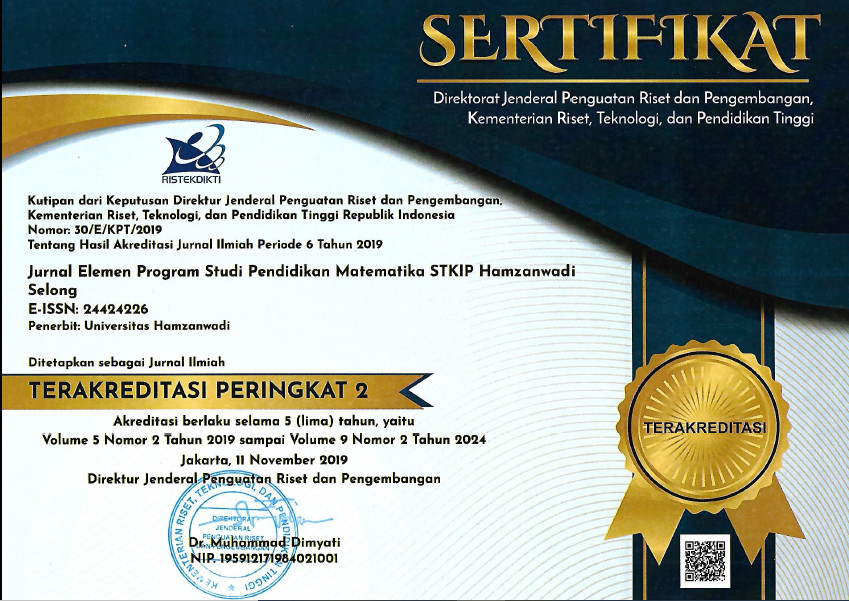Cognitive Processes of Using Representational Form in Mathematical Modeling Based on Gender Differences
DOI:
https://doi.org/10.29408/jel.v7i2.3627Keywords:
cognitive process, gender, mathematical modelingAbstract
The process of thinking in formulating a mathematical model requires cognitive processes. In learning mathematics, one of the factors that influence mathematics ability is gender differences. This research explores and provides an overview of the cognitive processes, especially using the representational form in mathematical modeling regarding gender differences. The type of research used is descriptive exploratory with a qualitative approach. The research subjects were 36 pre-service teachers in the mathematics education study program, consists of 18 males and 18 females. The instruments were a written test and an interview guide sheet. The result shows that males get higher percentages than females to answer the representational problem correctly. In conclusion, both males and females solve the graph problem using representative form through three components of the cognitive process. The first and second component, namely knowing and applying, shows the same behavior: retrieving the information from the mathematical problem and displaying the information into the graph. For the third component, reasoning also offers the same behavior because the truth of the graph that justifies refers to the mathematical properties. The study implies that it might be the same treatment for males and females to improve representational form regarding the components of cognitive process, namely, knowing, applying, and reasoning.References
Berry, J. (2002). Developing mathematical modelling skills: The role of CAS. ZDM– The International Journal on Mathematics Education, 34(5), 212–220. https://doi.org/10.1007/BF02655824.
Blum, W., & Niss, M. (1991). Applied mathematical problem solving, modeling, applications, and links to other subjects – state trends and issues in mathematics instruction. Educational Studies in Mathematics, 22, 37–68. https://doi.org/10.1007/BF00302716.
Blum, W., & Leiß, D. (2007). How do students’ and teachers deal with modelling problems? In Haines, C. et al. (Eds), Mathematical Modelling: Education, Engineering and Economics. Chichester: Horwood, 222-231. https://doi.org/10.1533/9780857099419.5.221.
De Lange, J. (2006). Mathematical literacy for living from OECD-PISA perspective. Tsukuba Journal of Educational Study in Mathematics, 25(1), 13-35.
Ferri, R.B. (2006). Theoretical and empirical differentiations of phases in the modelling process. Zentralblatt für Didaktik der Mathematik 38, 86–95. https://doi.org/10.1007/BF02655883.
Ferri, R. B. (2007). Personal experiences and extra-mathematical knowledge as an influence factor on modelling routes of pupils. In Pitta-Pantazi, D & Philippou, G. (Eds): CERME 5 – Proceedings of the Fifth Congress of the European Society for Research in Mathematics Education, 2080-2089.
Ferri, R.B. (2010). On the influence of mathematical thinking styles on learners’ modeling behavior. J. Math Didakt, 31, 99–118. https://doi.org/10.1007/s13138-010-0009-8.
Fuad, M. N. (2016). Representasi matematis siswa sma dalam memecahkan masalah persamaan kuadrat ditinjau dari perbedaan gender. Kreano: Jurnal Matematika Kreatif Inovatif, 7(2). 145-152. https://doi.org/10.15294/kreano.v7i2.5854.
Haines C., & Crouch R. (2007) Mathematical modelling and applications: ability and competence frameworks. In Blum W., Galbraith P. L., Henn H. W., Niss M. (eds.), Modelling and Applications in Mathematics Education. New ICMI Study Series, Vol. 10. Springer, Boston, MA. https://doi.org/10.1007/978-0-387-29822-1_46.
Hartono, Y. (2020). Mathematical modelling in problem solving. Journal of Physics: Conference Series, 1480(1), 012001. https://doi.org/10.1088/1742-6596/1480/1/012001.
Huda, U., Musdi, E., & Nari, N. (2019). Analisis kemampuan representasi matematis siswa dalam menyelesaikan soal pemecahan masalah matematika. Jurnal TA’DIB, 22(1), 19-25. https://doi.org/10.31958/jt.v22i1.1226.
Keitel, C. (1998). Social justice and mathematics education gender, class, ethnicity and the politics of schooling. Berlin: Freie Universität Berlin.
Kemdikbud. (2014). Mathematics cognitive processes. Jakarta: Kemdikbud.
Krutetski,V.A. (1976). The psychology of mathematical abilities in school children. Chicago: The University of Chicago Press.
Kurniadi, E., Darmawijoyo, & Pratiwi, W.D. (2019). Developing a learning design of mathematical modelling courses on understanding basic concept of mathematical modelling. Journal of Physics: Conference Series, 1480(1), 012033. https://doi.org/10.1088/1742-6596/1480/1/012033.
Maaß, K. (2006). What are modelling competencies? Zentralblatt für Didaktik der Mathematik, 38, 113–142. https://doi.org/10.1007/BF02655885.
Montague, M., Krawec, J., Enders, C., & Dietz, S. (2014). The effects of cognitive strategy instruction on math problem solving of middle-school students of varying ability. Journal of Educational Psychology, 106(2), 469-481. https://doi.org/10.1037/a0035176.
Montague, M., Warger, C., & Morgan, T. H. (2000). Solve it! Strategy instruction to improve mathematical problem solving. Learning Disabilities Research & Practice, 15(2), 110–116. https://doi.org/10.1207/SLDRP1502_7.
NCTM. (2000). Principles and standards for school mathematics. Virginia: NCTM.
Neumann, I., Duchhardt, C., Grüßing, M., Heinze, A., Knopp, E., & Ehmke, T. (2013). Modeling and assessing mathematical competence over the life span. Journal for educational research online, 5(2), 80-109.
Riyanto, B., Zulkardi, Putri, R. I. I., & Darmawijoyo. (2019). Senior high school mathematics learning through mathematics modeling approach. Journal on Mathematics Education, 10(3), 425–444. https://doi.org/10.22342/jme.10.3.8746.425-444.
Umaroh, U., & Pujiastuti, H. (2020). Analisis kemampuan representasi matematis siswa dalam mengerjakan soal PISA ditinjau dari perbedaan gender. Jurnal Pendidikan Matematika Raflesia, 5(2), 40-53.
Stillman, G., & Brown, J. P. (2014). Evidence of implemented anticipation in mathematising by beginning modellers. Mathematics Education Research Journal, 26(4), 763–789. https://doi.org/10.1007/s13394-014-0119-6.
Strauss, A., & Corbin, J. M. (1990). Basics of qualitative research: Grounded theory procedures and techniques. Thousand Oaks, CA: Sage Publications, Inc.
Sugiyono. (2016). Metode penelitian kuantitatif, kualitatif dan R & D. Bandung: Alfabeta.
Wei, W., Lu, H., Zhao, H., Chen, C., Dong, Q., & Zhou, X. (2012). Gender differences in children’s arithmetic performance are accounted for by gender differences in language abilities. Psychological Science, 23(3), 320–330. https://doi.org/10.1177/0956797611427168.
Downloads
Published
How to Cite
Issue
Section
License
Authors who publish with the Jurnal Elemen agree to the following terms:
- Authors retain copyright and grant the journal right of first publication with the work simultaneously licensed under Creative Commons Attribution-ShareAlike 4.0 International License (CC BY-SA 4.0).
- Authors are able to enter into separate, additional contractual arrangements for the distribution of the journal's published version of the work (e.g., post it to an institutional repository or publish it in a book), with an acknowledgment of its initial publication in this journal.
- Authors are permitted and encouraged to post their work online (e.g., in institutional repositories or on their website) prior to and during the submission process, as it can lead to productive exchanges, as well as earlier and greater citation of published work.
Jurnal Elemen is licensed under a Creative Commons Attribution-ShareAlike 4.0 International License






